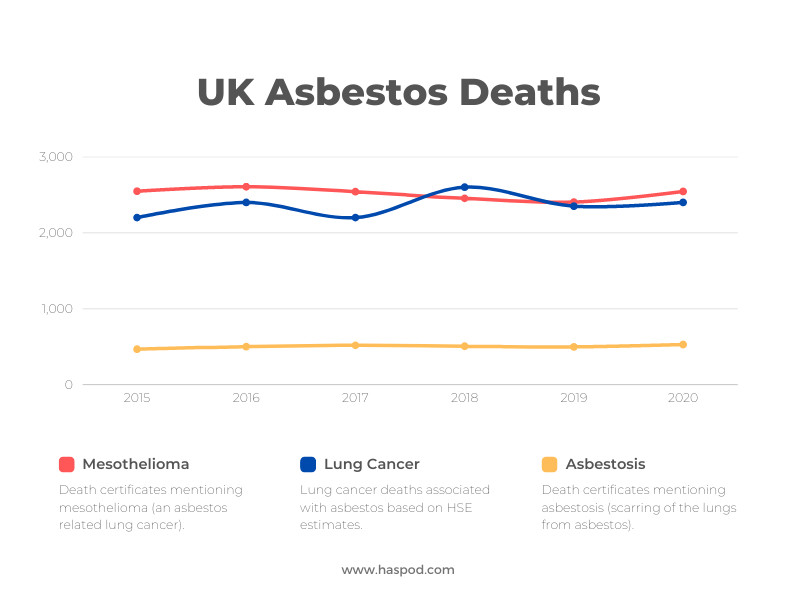14th June, 2022
Asbestos Types And Colours Explained
When you hear people talk about the types of asbestos, you will often hear them referred to by colour, like blue asbestos or white asbestos. Despite the names, you can't actually identify asbestos by colour, but there are three main types you need to know about.

Asbestos was an extremely popular and widely used material in the construction industry. It was cheap, in good supply, strong, and insulating.
If you needed materials to be hard-wearing, use asbestos. If you needed materials to have fire protection, use asbestos. If you needed materials to be cheap, use asbestos. Asbestos was used in thousands of building products.
Unfortunately, while the properties of asbestos made it a dream building product, that dream soon became a nightmare when the health effects of asbestos started to catch up with those using it.
Although asbestos is now banned in the UK, because of past use, it is still present in hundreds of thousands of buildings.
Asbestos kills thousands of people in the UK each year, figures are currently estimated at around 5,000 - considerably higher than the number of people killed in all work-related accidents combined.
Asbestos is still a very real health threat despite being banned nearly 20 years ago.

What are the types of asbestos?
Three main types of asbestos were used in the UK before a ban on all use of asbestos in 1999. These three types of asbestos are:
- Chrysotile
- Amosite
- Crocidolite
While you are not going to be choosing between the different types of asbestos, it is still important to know about them.
When you have an asbestos survey carried out for a construction project, or for the occupation and management of a building, it will tell you what type of asbestos is present.
You might have all three in different areas or just one type, and the action needed will be impacted by what type of asbestos is found.
What colour is asbestos?
Asbestos was simple to use, but not so simple to say. Asbestos names are a bit of a mouthful, so the different types of asbestos are often identified by colour:
- White Asbestos (Chrysotile)
- Brown Asbestos (Amosite)
- Blue Asbestos (Crocidolite)
When you hear people talk about the types of asbestos, you will often hear them referred to by colour, like blue asbestos or white asbestos.
But these are the colours you would see when looking at fibres under a microscope. Not in a building material.
A product that contains white asbestos won't necessarily be white. It could be grey (e.g. asbestos cement), black (e.g. asbestos floor tiles), or any other colour. And an asbestos product that contains blue asbestos is unlikely to be blue.
Despite the names (blue, brown and white asbestos), you can't identify asbestos by its colour under normal conditions. In fact, you can't actually see asbestos fibres because they are so small. And these tiny fibres will often be mixed in with other materials to make a building product.

That's why asbestos surveyors will usually take a sample of any materials they suspect might contain asbestos. Even asbestos can't tell what asbestos has been used until they get it checked under a microscope.
So, to be sure, you will need an asbestos survey to sample and identify if a material contains asbestos, and what type of asbestos it is.
Chrysotile (White)
Chrysotile asbestos is also known as white asbestos.
Chrysotile (white) asbestos was the most commonly used type of asbestos, and it was the last asbestos type banned in the UK, finally banned in 1999.

This type of asbestos can be found in many building products from textured coatings like artex to cement products, floor tiles, roofing and even toilet seats.
White asbestos is less deadly than blue and brown asbestos, but it is still a hazardous material. All types of asbestos can lead to serious and fatal diseases such as mesothelioma (a deadly asbestos cancer of the lungs) and asbestos-related lung cancer, and asbestosis.
Amosite (Brown)
Amosite asbestos is also known as brown asbestos.
Amosite (brown) asbestos was banned in the UK in 1985, along with crocidolite (blue) asbestos.
Amosite asbestos fibres have a higher risk compared to chrysotile (white) asbestos, which is why it was banned over 10 years earlier.
Sprayed coatings, lagging and insulating boards are more likely to contain blue or brown asbestos.
Crocidolite (Blue)
Crocidolite asbestos is also known as blue asbestos.
Crocidolite (blue) asbestos was banned in the UK in 1985, along with amosite (brown) asbestos.
Crocidolite fibres are extremely thin, making it the most deadly type of asbestos if disturbed. This is because the fibres will remain in the air longer, and once inhaled can easily slip through your respiratory system and hook into your lungs and chest lining where they do their damage.
Remember, you can't see asbestos fibres. A material containing blue asbestos won't be blue to look at! It's only once you get the fibres under a microscope that you can tell what type and colour they are.

Other asbestos types
And just a quick mention of other asbestos types. We have only mentioned the main 3 asbestos types in this article for a reason, these are the only 3 you are likely to see on an asbestos survey.
There are some other asbestos types (anthophyllite, tremolite and actinolite), but they were never used commercially in the UK.
These types of asbestos were only usually found as contaminants in other materials, rather than being specifically used. They don't have their own colour classifications.
Remember, all asbestos is dangerous. No type or colour of asbestos is safe. Use the free asbestos awareness toolbox talk to stay refreshed.
This article was written by Emma at HASpod. Emma has over 10 years experience in health and safety and BSc (Hons) Construction Management. She is NEBOSH qualified and Tech IOSH.
Are You Asbestos Aware?
Take our asbestos awareness elearning course and get your certificate today.
Asbestos Awareness CourseRecent posts like this...

10 Asbestos Awareness Questions And Answers Explained
If you have had, or are about to refresh, your asbestos awareness training, you should be able to answer these 10 asbestos awareness questions. Don't worry if you are not sure about the answers - we explain them in this post to help prepare you for your asbestos awareness training.
Read Post
The Risk Of Asbestos In Artex Ceilings
Many buildings contain artex and other textured coatings on walls and ceilings that may contain asbestos. The biggest risk is not the artex itself, but the potentially deadly fibres contained in it. In this post, we look at when you should be worried, and what the law says about asbestos in artex.
Read Post
The Two Types Of Asbestos Survey (And When You Need Them)
There are two types of asbestos survey, the management asbestos survey, and the refurbishment and demolition asbestos survey. A building may require one type, or both, depending on the use of the building and the work planned.
Read Post